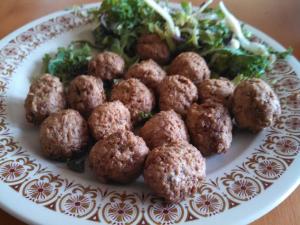Trader Joe’s Meatless Meatballs
Posted: July 10, 2014 Filed under: Frozen Food, Trader Joe's Brand, Vegan, Vegetables, Vegetarian | Tags: 2 stars, italian food, meatballs, textured soy protein, Vegan, vegetarian food 12 CommentsWe return again to the strange shores of vegan cuisine to take a look at Trader Joe’s Meatless Meatballs. We’ve looked at a good number of vegetarian and vegan alternatives to this meaty world we live in – from soy “ice cream” to chicken-free chicken nuggets.
In general, I find that vegetarian food really shines when it’s not getting hung up on trying to be the doppleganger of meat products, as with Trader Joe’s Vegetable Masala Burgers, and just does it’s own thing. The worst sins of vegan cuisine seem to occur when somebody decides that, goddammit, yes, I need to make a turkey out of tofu. Vegetable dishes are good as vegetables, and meat dishes are good as meat – there’s no need for vegetables to be all things to all people. Nevertheless, I’m always excited to be proved wrong in novel ways, hence the acquisition of these “meat”balls.
TJ’s comes straight out and calls their meatless meatballs, “a delicious meat-free substitute for any meal” right there on the package, without even a hint of modesty. I wouldn’t go that far, but the meatballs do delivery a surprisingly rich and full, if not exactly meaty, flavor. The meatlessballs, for lack of a better word, replicate the texture and mouthfeel of a standard party meatball pretty closely. The bite of the ball is moist and a little chewy – holding together well, and breaking up much as a bit of ground beef would. Coated with a heavy sauce, or mixed into a plate of pasta you wouldn’t notice much of a difference. Taken by itself, however, the meatlessball tastes, and more importantly, smells very dissimilar.
A good job was done to season the meatlessballs in such a way that they are roughly approximate to a normal meatball, but there’s no hiding the sort of soybean-y aftertaste when eaten straight off the plate. There’s nothing here of the fatty, visceral taste of the meatball – instead there’s a thinner, somewhat vegetable blandness. This difference in taste is rather mild, however, which means it can be hidden very effectively under a good marinera or similar sauce. More problematic, for those seeking a true meat substitute, is the smell wich has nothing of the savory, fatty scent of a simmering meatball. Instead, it smells like what it is – a bunch of hot soy. It’s a strong enough scent that it might make you think twice about digging in.
When you pop this bag open, the first thing you should realize is that you
are getting a ton of these guys. These are cocktail meatballs, not the big honking ones you get in Trader Joe’s regular bag of frozen meatballs. The move feels like it may be a practical one, as even at their smaller size the meatless meatballs have a certain tendency to break up if played around with too much. On the plus side, they’re down right healthy compared to Trader Joe’s ordinary beef variety meatballs. Each six meatball serving has only 140 calories, 45 from fat, and 13 whopping grams of protein.
How do such meatless balls manage such a feat? Through the magic of textured soy protein, of course.
To level with you, I generally react to this sort of psuedo-meat like a horse being lead up to Frakenstein’s castle. There’s something strange and unnatural about it that makes me balk. Meat I get. It’s easy to get answers out of meat. “Hey, what’s this meatball made out of?” “A bunch of dead cow.” That’s a straight forward answer. The answers are harder with meatless meat products, because all of a sudden I’m being tricked, right from the start. Nothing is what it appears, but instead a complex masquerade of strange technical processes meant to fool me into thinking I’m eating meat. That’s vaguely sinister – and such weird yet innocuous phrases as “textured soy protein” only make me nervous.
Textured soy protein or “TSP” is, in fact, kind of weird and sinister stuff. It’s basically the styrofoam of the food world, used since the 1960’s by the Archer Dale Midland company to pad out meat with filler material. It’s what happens when you heat soy bean flour to high temperatures that it melts, then is extruded from a nozzle as “a fibrous, insoluble, porous network that can soak up as much as three times its weight in liquids” (http://en.wikipedia.org/wiki/Textured_vegetable_protein). Does that sound amazing? Not really, but they tell you not to ask about how sausage is made either.
That may sound like I’m being harsh, but I’m just trying to be accurate. In terms of texture and even, to a fair degree, taste these “meat”balls really are good substitutes for real meatballs. But to say, as Trader Joe’s does, that they’re a substitute for “any recipe” isn’t one I’d stand behind. Taken as a small asset in a larger dish, in a sloppy meatball sandwich say, they work beautifully, as they would for any vegetarian just looking to get a little variety in their diet. However, in a dish where the meatballs are showcased instead of hidden behind other, stronger flavors they’re unlikely to please the table.
The Breakdown
Would I Recommend It: Not to meat eaters, possibly to vegetarians.
Would I Buy It Again: Not I, I’ll stick to TJ’s lean turkey variety.
Final Synopsis: Fake meatballs suitable for pasta but not soup.




Recent Comments